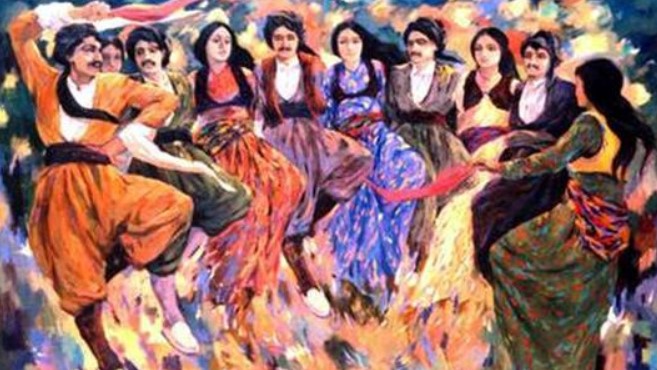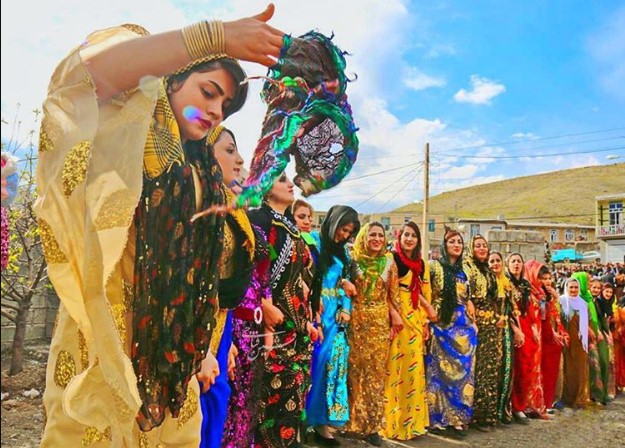The Kurdish culture has been around since antiquity. Records about the Kurds’ people, their way of life, and customs are dated all the way back to the 3rd millennium BC (over 3,500 years ago!)
The Kurds’ many customs are still practiced today, such as the Kurdish dance, which perfectly showcases the ancient grace and beauty of this century-old civilization. The dance has been passed down from generation to generation and is still being regularly performed today at various cultural events and celebrations.
The answer to this question isn’t as straightforward as it may seem, for many different reasons. But we’ll look into it regardless in this article, in which we’ll explore not just the origin and history of the Kurdish dance, but also many other things like the costumes and the music!
Table of Contents
What Is The Kurdish Dance?
The real meaning of Kurdish dance is that it’s not a particular kind of dance form at all. Rather, it’s a “group” of traditional dances that is performed by the Kurdish people (hence the name).
We highlighted the word “group” because when you refer to the Kurdish dance, you’re referring to a collection of different dances and variations in the Kurdish culture, with the most popular being Dilan, Chapi, Sorani, Sepe, Kurmanji, and Geryan. Each dance is further broken down into small subsets and variations.
Diasporas of the Kurds around the globe will practice or traditionally perform different kinds of dance. For example, different cities where the Kurds live are known for different variations:
- Gaziantep, Turkey, for the Keçiko and Çepikli dances
- Diyarbakir, Turkey, for the Çeçeno dance
- Sheikhani dance is known for being very common in Behdinan, which is an area in Kurdistan, Iraq where the Kurmanji language is spoken.
The Kurdish Jews and Assyrian diasporas also perform Sheikhani.
But whatever the dance or the variation, Kurdish dances as a whole are a symbolic expression of Kurdish culture and history. Each movement reflects the values and beliefs of the community, which is why we find them so interesting, to begin with!
Did you know: Butoh Dance – The Dance Of Darkness
Characteristics Of Kurdish Dance
The dance can take many different forms: from a circle dance, a semi-circle dance, to a line dance, depending on the variation.
And unlike many other Middle Eastern dances, Kurdish dances aren’t segregated based on sex. Men and women can dance in the same circle!
Dancers will link up with each other to form a group by holding hands and forming files shoulder-to-shoulder. They usually interlace their pinky fingers or place their hands across the lower backs of the people next to them.
Male dancers will differentiate themselves by making powerful, speedy movements. While female dancers will perform with more graceful and delicate movements with their feet, shoulders, knees, and necks.
Of course, the dance is performed in traditional Kurdish music. And if you ever get the chance to see one live, the performers will be dressed in traditional Kurdish costumes, too.
It’s performed in many different settings, from cultural events and celebrations to weddings and gatherings. As long as there’s a joyous event in the local Kurdish community, you can bet that there’ll be a dance!
In fact, these dances are very commonly used as a traditional Kurdish wedding dance.
Check more: Dabke Dance
Kurdish Dance Origin & History
Like many old folk dances, the exact origins of the Kurdish dance are not well-documented. But what little historical records we do have all pointed to it having been performed by the Kurds for centuries.
The Kurdish people have lived in many different regions over the centuries. Before the Islamic conquest in the 7th century, the Kurds inhabited a vast area that spans modern-day Iran, Iraq, Syria, Turkey, and Armenia. Particularly, the Kurds lived in the mountainous areas of Iran and Azerbaijan.
Since they lived in such a vast area, the Kurds were influenced by many different flows of cultures from Europe as well as the Middle East. It’s the reason why the Kurdish dance is so diverse, with dozens of variations and forms. As the people and their culture are shaped by the region’s geopolitical, social, and cultural events, the dance evolved with them, too.
But, for many people, the Kurdish dance is more than just a symbol of the Kurds and their culture. It’s also a symbol of resistance.
For example, post-World War I, in the area of Northern Kurdistan, the Kurdish dance was suppressed and banned in Türkiye. But the Kurds still continued to perform their dances in secret with the hope of preserving the Kurdish culture and heritage.
In the 20th century, the Kurdish dance gained popularity as a form of cultural expression and was performed at various cultural events and festivals.
And today, in the 21st century, while there are still a lot of geopolitical issues surrounding the Kurds and their culture, their dances are performed worldwide.
Kurdish Dance Types
There are many different types of Kurdish dance, each reflecting the cultural influences and traditions of a specific region or group. Some of the most well-known Kurdish dance styles include:
Halparke
This is a lively and energetic circle dance that both men and women can perform. They will stand shoulder-to-shoulder in a display of unity and community.
Notably, in the Halparke, no one stands in the center of the dance group. This symbolizes how no one member is more important than the other in the dance circle.
The leader of the dance, called “Sarchupi,” will lead the rest of the dancers (“Gawanís”). They will determine the rhythm and movements that the Gawanís have to follow.
Sometimes, the Sarchupi will jump out of the circle and perform a solo routine with nimble moves and jumps. Meanwhile, the Gawanís perform their own patterns in smooth, flexible movements.
It’s said that in Halparke, each dancer’s body should be wild and free, like that of a “handkerchief in the wind.”
Another very remarkable characteristic of the Halparke is that in the hand of the Sarchupi will be a handkerchief. The small piece of cloth represents a flag calling for an uprising (which is why the Halparke is often attributed as a martial dance).
The dancers move in a circle, stomping the soil to call for an “agricultural revolution” and hope for good crops in the coming months and years.
Sorani
In Sorani dances, the focus is placed on the continuous swaying of the dancers’ bodies. The footwork is also much more delicate and soft than those in Halparke.
Sepe & Chapi
In Sepe and Chapi dances, there’s the addition of an advance-retreat movement. Here, the dancers in a circle will take two steps forward in unison, then fall back two steps and keep on dancing. The undulating pattern of the circular can be very mesmerizing to watch!
Kurmanji
Kurmanji dances are among the most “militaristic” variations in the Kurdish dance. The dancers will hold their bodies stiff and erect, striking out with fast, forceful, and impressive moments almost like a marching brigade.
Geryan
The Geryan is known for its speed. In fact, it is the fastest Kurdish dance variation out of them all.
Kurdish Dance Steps & Movements
The specific dance steps and movements will obviously depend on the variation of the dance you’re performing. Still, quite a few basic moves are shared between them all.
Kurdish dances are never performed alone. They’re always performed in a large group of people since the Kurds treasure their community. The dancers will interlock their hands and be led by a lead dancer (Sarchupi), who may hold a handkerchief.
The basic steps in the Kurdish dance typically involve moving the feet quickly and rhythmically, while the arms and upper body are used for emphasis and expression. Some dances also incorporate hand gestures, such as clapping or waving, to add an additional layer of complexity to the performance.
The intensity of the movements will differ depending on the variation. If you perform the Sorani, the dances will be softer and more delicate than a martial-style dance like the Kurmanji, which is known for its strong and forceful movements.
Tempo and dynamic will depend on the sexes, too. Male dancers will usually have stronger and more impressive moves. Meanwhile, female dancers will dance more flexibly, using their hands, shoulders, and necks to emphasize their movements.
Kurdish Dance Clothes
The traditional attire worn by Kurdish dancers is an important part of the dance performance. If the dance is a reflection of the culture, then the costumes are the reflection of the people.
The clothes worn by Kurdish dancers are brightly colored, with intricate designs and patterns, and often incorporate various cultural symbols and motifs.
For men, the traditional Kurdish attire typically consists of a long tunic or shirt, pants, and a headscarf. The tunic is usually made of brightly colored fabric, intricate designs and patterns, and sometimes embroidered with cultural symbols and motifs. The pants are typically loose and comfortable, allowing great freedom of movement.
For women, the traditional attire typically consists of a long skirt, a blouse, and a headscarf. The skirt is usually made of brightly colored fabric. Similar to the men’s tunics, the skirts of the female dancers are also brightly decorated with motifs and symbols. The blouse (usually embroidered) is loose and comfortable, with long sleeves and a high neckline.
The headscarf (keffiyeh) is the most important part of the attire and is present in both male and female costumes.
Kurdish Dance Music & Instruments
There can be no dance without music!
Traditional Kurdish dances are performed atop Kurdish music which is characterized by fast-paced beats and intricate melodies.
A live band usually plays the tunes using an assortment of traditional instruments, like the Daf, Ney, Sorna, Dhol, Tonbak, Tanbur, Nayeh, Kamancheh, Divan, and Shimshal.
To go into specifics, the daf is a thin frame drum that’s used to establish a rhythm and make the beats that the dancers can perform to. The ney, on the other hand, is akin to a flute and used as part of the melodic section of the band.
Each instrument has a special role in the band that, when properly combined together, sounds can weave an incredible soundscape that’ll delight your ears as the dancers draw your eyes.
Final Words
From its origin and history to the steps, movements, clothes, and music, the Kurdish dance is a beautiful and dynamic art form that is an important part of the Kurds’ cultural heritage. It’s a visual celebration of life, love, and tradition that continues to be enjoyed and cherished by generations of Kurdish people. And now, with the Internet and the many Kurdish dance troupes that tour the globes, it won’t be hard to find an event somewhere close to you where you can see it being performed with your own eyes!
What’s the most interesting part of the Kurdish dance, in your opinion? Tell us in the comment section below!



